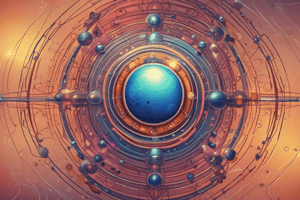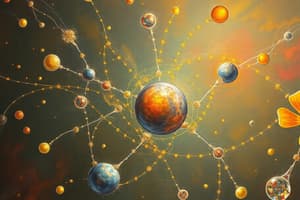Podcast
Questions and Answers
An atom has a mass number of 37 and contains 17 protons. How many neutrons does this atom possess?
An atom has a mass number of 37 and contains 17 protons. How many neutrons does this atom possess?
- 54
- 17
- 20 (correct)
- 37
Which statement accurately describes the relationship between an element's atomic number and its placement on the periodic table?
Which statement accurately describes the relationship between an element's atomic number and its placement on the periodic table?
- Elements are arranged by increasing atomic number, determining their position and properties. (correct)
- Elements are arranged randomly based on when they were discovered.
- Elements are arranged by the number of valence electrons, dictating their period and reactivity.
- Elements are arranged by increasing atomic mass, with isotopes placed in the same group.
Consider two isotopes of oxygen, Oxygen-16 and Oxygen-18. Which of the following statements accurately describes the difference between them?
Consider two isotopes of oxygen, Oxygen-16 and Oxygen-18. Which of the following statements accurately describes the difference between them?
- Oxygen-18 has more neutrons than Oxygen-16. (correct)
- Oxygen-16 has more electrons than Oxygen-18.
- Oxygen-16 and Oxygen-18 are the same, isotopes are identical.
- Oxygen-18 has more protons than Oxygen-16.
An element is in group 16 (also known as group 6A or the chalcogens) of the periodic table. How many valence electrons does an atom of this element possess?
An element is in group 16 (also known as group 6A or the chalcogens) of the periodic table. How many valence electrons does an atom of this element possess?
How are protons and neutrons related at the subatomic level?
How are protons and neutrons related at the subatomic level?
Flashcards
Atom
Atom
Smallest part of an element retaining its properties.
Electron
Electron
Negatively charged particle orbiting the nucleus.
Electron Cloud
Electron Cloud
Region of negative charge surrounding the nucleus where electrons are found.
Neutron
Neutron
Signup and view all the flashcards
Nucleus
Nucleus
Signup and view all the flashcards
Study Notes
- Atom: The smallest component of an element that retains the element's properties.
- Electron: A negatively charged subatomic particle located in the electron cloud.
- Electron Cloud: An area with a negative charge that surrounds an atom's nucleus.
- Neutron: A neutral subatomic particle that resides in the nucleus.
- Nucleus: The positively charged center of an atom, containing protons and neutrons.
- Proton: A positive subatomic particle found within the nucleus of an atom.
- Quark: A very small subatomic particle that constitutes protons and neutrons.
- Atomic Number: Corresponds to the number of protons present in an atom's nucleus.
- Average Atomic Mass: Determined by summing the masses of an element's isotopes, each multiplied by its natural abundance.
- Isotope: Atoms of the same element characterized by varying numbers of neutrons.
- Mass Number: Represents the total count of protons and neutrons in an atom.
- Valence Electrons: Electrons found in the outermost energy level of an atom.
- Valence Number: Refers to the number of electrons an atom can lose, gain, or share.
- Electron Dot Diagram: A representation of an atom displaying its valence electrons.
- Group (Family): A column of elements in the periodic table sharing similar properties.
- Period: A horizontal row in the periodic table indicating the number of energy levels for elements in that row.
- Periodic Table: An arrangement of chemical elements by atomic number, organized in rows (periods) and columns (groups or families) based on similar atomic structure.
Studying That Suits You
Use AI to generate personalized quizzes and flashcards to suit your learning preferences.
Description
Explore the fundamental components of atoms, including electrons, protons, and neutrons. Understand the structure of the atom, including the nucleus and electron cloud. Learn about atomic number, mass number, isotopes, and valence electrons.




